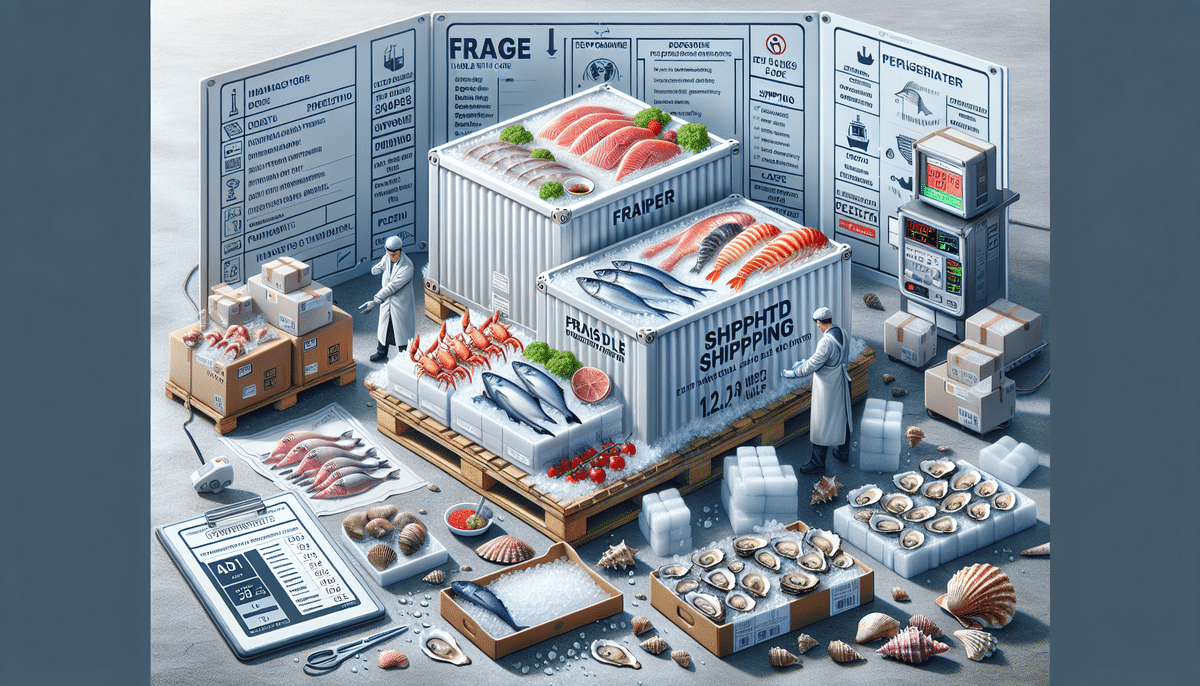FedEx Offers Comprehensive Guidelines for Shipping Perishable Seafood
Shipping perishable seafood can be a daunting task, especially if you're not familiar with the proper techniques and guidelines. Fortunately, FedEx provides a comprehensive set of guidelines designed to ensure your seafood arrives fresh, safe, and ready to be enjoyed. This article delves into these guidelines, offering detailed insights into the importance of proper shipping techniques, common challenges, essential packing materials, temperature control and monitoring, selecting the right shipping container, labeling and marking, navigating regulatory requirements, and best practices for collaborating with your shipping carrier while gathering customer feedback. Whether you're a seafood supplier, distributor, or seafood enthusiast, read on to master everything you need to know about shipping perishable seafood.
The Importance of Proper Shipping Techniques for Seafood
Proper shipping techniques are crucial when it comes to transporting perishable seafood. Seafood is highly perishable and sensitive to temperature fluctuations, making it susceptible to spoilage and bacterial growth. To ensure your seafood arrives at its destination fresh and safe for consumption, it's essential to use appropriate packing materials, maintain strict temperature control, and implement effective labeling and marking techniques. Failure to adhere to these practices can lead to spoiled seafood, dissatisfied customers, and even legal repercussions.
One of the most critical aspects of proper shipping is the use of insulated packaging. Insulated packaging maintains the seafood's temperature during transit, preventing spoilage or unsafe conditions. Additionally, accurate labeling and marking ensure that the seafood is handled and stored correctly throughout the shipping process. By following these steps, you can guarantee that your seafood arrives fresh and maintains high quality, fostering customer satisfaction and trust.
Common Challenges of Shipping Perishable Seafood
Shipping perishable seafood presents several challenges:
- Temperature Control: Maintaining a specific temperature range is vital to prevent spoilage and bacterial growth.
- Fragility: Seafood is delicate and can easily be damaged during handling and transport.
- Regulatory Compliance: Different countries have varying regulations regarding the import and export of seafood, including documentation, labeling, and packaging requirements.
- Cost: Specialized packaging, temperature-controlled transportation, and expedited delivery can significantly increase shipping costs, posing a barrier for small businesses competing in the global market.
Addressing these challenges requires meticulous planning, the right materials, and a reliable shipping partner knowledgeable in seafood logistics.
Understanding the Different Types of Seafood and Their Shipping Requirements
Different types of seafood have unique shipping requirements:
- Live Shellfish (e.g., oysters, clams): Require careful handling, cool and damp environments, and packaging that allows for adequate ventilation.
- Fish Fillets: Need to be kept within specific temperature ranges, typically between 32°F (0°C) and 40°F (4°C), to prevent spoilage.
Long-distance or extended shipments may necessitate additional measures like insulated packaging or dry ice to maintain freshness. Partnering with a reputable seafood shipping company ensures that these requirements are met, preserving the quality and safety of your seafood.
Essential Packing Materials for Shipping Perishable Seafood
Proper packing materials are essential for shipping perishable seafood:
- Insulated Packaging: Maintains the desired temperature during transit. Options include foam coolers, vacuum-sealed bags, or specialized insulated containers.
- Gel Packs or Dry Ice: Keeps the seafood cool throughout the shipping process.
- Bubble Wrap: Protects seafood from physical damage during transport.
Choosing the right materials depends on the shipment's duration and distance. Additionally, it's crucial to label packages appropriately and include necessary permits or certifications when shipping across state or international borders.
Temperature Control and Monitoring During Shipment
Maintaining strict temperature control is vital for ensuring seafood remains fresh:
- Ideal Temperature Range: Typically between 32°F (0°C) and 40°F (4°C), though live shellfish may have specific requirements.
- Temperature Monitoring Systems: Use reliable systems to track temperature throughout the shipping process.
- Insulated Packaging and Gel Packs: Enhance temperature regulation, especially for longer shipments.
Selecting a shipping carrier that offers temperature-controlled transportation and minimizes transit times reduces the risk of spoilage.
How to Choose the Right Shipping Container for Your Seafood
Selecting the appropriate shipping container is essential for the safe transport of seafood:
- Insulated Containers: Prevent temperature fluctuations, maintaining the seafood's freshness.
- Container Size: Ensure the container is appropriately sized to prevent seafood from shifting or being packed too tightly, which can cause damage.
Different types of seafood may require specific containers. For example, live shellfish need containers that allow for ventilation, while fish fillets benefit from vacuum-sealed packaging.
Tips for Labeling and Marking Your Seafood Shipment
Proper labeling and marking are critical for seafood shipments:
- Content Identification: Clearly label the package contents and temperature requirements.
- Handling Instructions: Include instructions such as "Do not freeze" or "Handle with care."
- Regulatory Compliance: Adhere to destination-specific labeling requirements, such as those set by the European Union for species, production methods, and catch areas.
Accurate labeling not only ensures proper handling but also builds trust with customers by demonstrating a commitment to quality and compliance.
Navigating Regulatory Requirements for Shipping Seafood
Shipping perishable seafood involves adhering to various regulatory requirements:
- FDA Seafood HACCP Regulations: Require seafood processors and distributors to identify and control potential food safety hazards.
- Import and Export Restrictions: Different countries have specific regulations governing the shipment of seafood, including documentation and packaging standards.
Understanding and complying with these regulations is crucial to avoid delays, fines, or shipment rejections. Partnering with a knowledgeable shipping carrier can help ensure compliance and smooth logistics.
Best Practices for Working with Your Shipping Carrier and Receiving Customer Feedback
Effective collaboration with your shipping carrier and actively seeking customer feedback are key to successful seafood shipments:
- Select a Reliable Carrier: Choose a carrier experienced in shipping perishable goods and offering temperature-controlled transportation.
- Clear Communication: Provide carriers with detailed instructions and necessary information to ensure proper handling.
- Customer Feedback: Encourage and monitor feedback to identify and address any issues promptly, fostering continuous improvement and customer satisfaction.
Implementing these best practices helps ensure that your seafood arrives fresh and that your customers remain satisfied with their purchases.
In conclusion, shipping perishable seafood requires meticulous planning, attention to detail, and adherence to established guidelines. By following FedEx's comprehensive shipping guidelines, you can ensure that your seafood arrives fresh, safe, and ready to be enjoyed. Understanding proper shipping techniques, addressing common challenges, selecting appropriate packing materials and containers, maintaining strict temperature control, complying with regulatory requirements, and collaborating effectively with your shipping carrier are all essential steps in the successful transportation of perishable seafood. Implement these practices to guarantee the safety and quality of your seafood shipments, ultimately leading to satisfied customers and a thriving business.






















